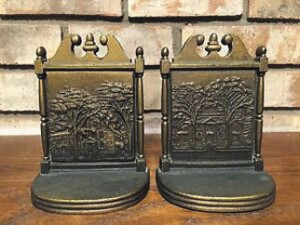While there are those who would argue that physical books will soon be completely replaced by electronic books, I for one fall into the category of those who believe that a tablet will never replace the joy of sitting in your favorite chair with an old book. The discolored pages that have held up through the decades, the feel of the old embossed cover and even the “smell” of an old book is something that cannot be duplicated with a tablet. As to their aesthetic appeal, well, just try decorating the shelves of your office with a stack of Kindles. True, a tablet is much easier to take on vacation than a box of the classics, but as long as people read there will be books and as long as there are books, there will be bookends.
Bookends became a standard household item in the last quarter of the 19th Century and remained so through WWII. While their original intent was to secure books displayed on a table top or shelf, they soon came to be appreciated as a form of art and were often displayed independently. Collectors watch for sets and individual bookends made of bronze, hammered copper, cast iron and ceramics.
L-shaped, poly-chromed cast iron ends from the “Masters of Metalwork,” Bradley and Hubbard, are in demand and seeing high realized prices. Mass produced from 1920-1940 they were sold at some of the top stores of the day including Sears and Roebucks and Montgomery. They are extremely heavy for their size and are appreciated for their fine finish and attention to detail.
Hammered copper and cast brass bookends from Roycroft are also popular with collectors. Founded in 1895 by Elbert Hubbard, the Roycroft Community was made up of a group of artists from Buffalo, New York are who were highly influential in the development of the American Arts and Crafts movement. Their designs are vast and varied, running from elegant simplicity to elaborate floral and bird patterns. They are easily identified by their exceptional quality and will have the Roycroft impressed trademark.
Bronze bookends from the Art Deco years often resemble small pieces of sculpture. Female nudes were a favored topic matter as well as reproductions of famous art works like Rodin’s “Thinker.” Some of the bronze examples from 1920 through the late 1950s will be enhanced with colorful painting added to the molded designs. Company names to watch for include Marion Bronze of New Jersey and Pompeian Bronze.
Art pottery bookends from the great Ohio pottery factories of Rookwood and Roseville were manufactured from 1930-1950. The Roseville factory produced bookends in 20 of their most popular patterns including; Apple Blossom, Clematis and Pinecone. Rookwood created many beautiful bookends. The most desirable in the current market are their animal designs with both the “Panther” and “Raven” seeing realized prices in the $400-$600 range.
With the considerable age of good collectible bookends it is imperative that you inspect them carefully before purchasing. Look for fractures in metal and cracks or chips in ceramics. Watch for brass end that have had the patina scrubbed off and painted bronze ones that have had the paint retouched. Until next time . . . Linda
Linda Kennett is a professional liquidation consultant specializing in down-sizing for seniors and may be reached at 317-258-7835 or lkennett@indy.rr.com



